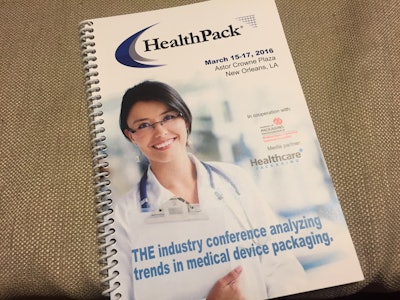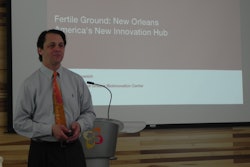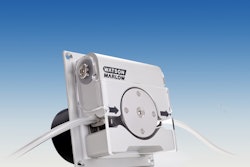
Innovation can have a variety of meanings to different people in healthcare packaging.
It can help give one company an edge over the other. It can help those on the front lines of patient care do their jobs better. It can help shape government policies on safety, and be the catalyst for raising standards.
But, it can also be painful—new regulations, new technologies, new machinery, new tests, etc.
HealthPack focused on this issue during their annual conference held earlier this year in New Orleans, including an exclusive survey conducted by Healthcare Packaging that took the industry's pulse on innovation and the struggles they may or may not have with it.
Immerse yourself in the customer's view
An opening keynote at a conference in the healthcare packaging field tends to talk about the challenges it faces and the technical points of the moment.
But, this year's opening remarks at HealthPack took a slightly different approach.
"The job that you are doing as your profession, you have a viable outlet where you can give back some of the fortune. You may not realize this on a daily basis, but being in an operating room, it does make a difference what you are doing."
These were some of the comments Reinhard Juraschek, Associate Director R&D at Johnson & Johnson/Ethicon, made as he spoke about assisting in surgeries and other procedures in third-world countries as part of a non-profit organization with which he works.
Juraschek's presentation focused on how the medical devices and their packaging truly impacted the people using them—and the importance of it.
"You should be really proud of what you are doing and the impact it has on society," he said.
As a result, he encouraged everyone to immerse themselves in the end customer's point-of-view.
"You're in a profession that impacts people's lives directly," he said. "Your packaging really makes a difference while [volunteers in third world countries] are working in less than optimal conditions. This is real life. The robustness and longevity of packaging and labeling is important. Keep the quality up."
Disruptive innovation
As the average lifespan of companies is declining, more executives are looking at their employees and asking, "How do we make it better, cheaper and faster?"
But, Ellen DiResta, an innovation professional and strategic advisor, challenged conference attendees to think about a different approach to making a profit and evolving as a company.
What executives need to say instead, she explained, is, "we can't sustain our market position anymore, so we need to disrupt the market."
Innovation is the key and the way to do that is by asking different questions.
"I want to know why people are doing what they are doing, so you can build a pipeline that is meaningful. You have to be willing to challenge your own assumptions," she said.
Stop assuming that as a company you already know why the end user is selecting the product.
DiResta said, "What your job is when it comes to innovation is to really think what's motivating your end user to accomplish their goal. How do we get them to open a package to make them feel more powerful?"
In other words, translate the feelings end users are having about products into the packaging.
First-hand experience
Who better to know what the end user is thinking than nurses and technicians who use the products in a real-life setting that HealthPack attendees create?
Three panelists, each of whom work in different areas of the healthcare field, gave feedback while opening medical packaging supplied by a number of manufacturers.
Reoccurring themes included expiration dates, pros and cons of color coding, opening expensive medical devices and sterility and size of the package.
All of the panelists agreed that a visible, easy-to-find and easy-to-read expiration date is crucial. For example, panelist Lance Beeson, said when dealing with heart valves, a nurse always calls out the size, manufacturer date and the expiration date, showing it to the doctor before it’s used.
Tanya Gillin explained that the more expensive the device, the more elaborate the packaging tends to be, which is why she explained that in many cases, a sales rep from the company is there during the surgery to show personnel how to use the packaging to ensure both the product and sterility are not compromised.
Healthcare professionals work in life or death situations, so packaging manufacturers have to keep their challenges in mind when designing products and packaging, Brice Chauvin explained.
"The faster you can safely open a package, the better," said Chauvin.
Innovation pain points
Innovation is not always easy, especially for the companies and employees tasked with keeping up with it.
To get a handle on what some of the issues are, Healthcare Packaging dove into innovations in medical device packaging as part of an exclusive survey that was presented during HealthPack.
The survey was sent both to the HealthPack and Healthcare Packaging email list. All responses were gathered between Nov. 30, 2015 and Jan. 1, 2016, representing the views of 146 end users. Healthcare Packaging filtered all suppliers from the results.
Of the respondents, 46% described their company as a medical device manufacturer, with 28% identifying themselves as a packaging engineer, followed by senior management.
The most frequently reported pain points were compliance with governing bodies, validation, packaging/device compatibility testing and resource constraints.
Looking further into the results, Healthcare Packaging compared pain points faced by both engineers and management.
Top pain points cited specifically by engineers were validation, lack of standard terminology, and corrective and preventative action activities. For management, anti-counterfeiting and packaging/device compatibility testing kept them up at night.
Company size also played a part in what pain points were cited. Smaller companies seemed to struggle the most with the actual testing, while larger companies cited resource constraints as their biggest issue.
Healthcare Packaging asked respondents to share how they balance being innovative while also complying with new rules and regulations.
Many of the open-ended respondents flat-out admitted it is extremely tough. Some said regulations must come first, while others said they just don't innovate at all because striking a balance is not feasible. A common answer to keeping up with regulations was education attained by attending seminars and learning from peers and experts.
HealthPack 2017 is scheduled for March 7 – 9 at the Denver Marriott City Center, Denver, Colo.



















